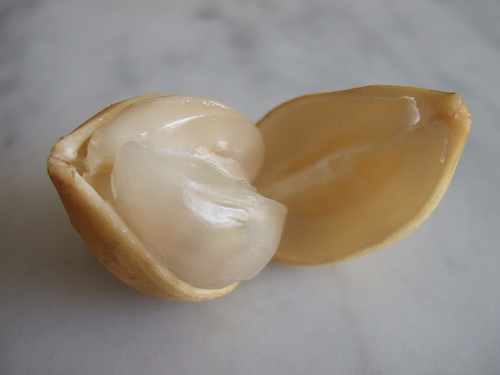Langsats are just one of those many exotic fruits from Southeast Asia.
- Langsat is the edible fruit of a tree that originates from countries of Southeast Asia, and it is commonly eaten raw, but can also be cooked.
- The scientific name of the tree bearing langsats is Lansium parasiticum, also known as Lansium domesticum, and it is from the family Meliaceae, the family of mahogany.
- ‘Langsat’ fruit is also known as ‘lanzone’, ‘lansone’, ‘langsak’, ‘longkong’, ‘duku’, and other names, depending on the country and language.
- The langsat tree typically grows to a height of 10 to 20 metres (33 to 66 feet), and the trees may bear fruit twice a year, depending on the climate.
- Langsat fruit are usually around 2 to 5 centimetres (0.8 to 2 inches) in length and ovoid or spherical in shape, and they grown in bunches of two to thirty.
Langsat
Image courtesy of Yun Huang Yong/Flickr
- The flavour of langsats is sweet to sour, and is often compared to a blend of grape and grapefruit.
- The flesh of langsats is a translucent white colour, while the skin is a yellow or brown colour and can either be thick or thin, depending on the variety, and is usually peeled off before eating.
- Each individual langsat contains five or six segments, and one to three seeds that expel a taste of bitterness once eaten.
- Langsats are high in vitamin B, phosphorus and vitamin A, and they contain other beneficial vitamins and minerals.
- When ripe, langsats can drop from their host tree with ease, even with just a few shakes, and once picked, they are best stored in cool conditions, or eaten soon after ripening.
Bibliography:
Health Benefits of Langsat Fruit, 2015, Medindia, http://www.medindia.net/patients/lifestyleandwellness/top-9-health-benefits-of-langsat-fruit.htm
Langsat and Duku, 1982, The Archives of The Rare Fruit Council of Australia, http://rfcarchives.org.au/Next/Fruits/LangsatDuku/LangsatDuku5-82.htm
Lansium Parasiticum, 2015, Wikipedia, https://en.wikipedia.org/wiki/Lansium_parasiticum
Morton J, Langsat, 1987, Purdue Agriculture, https://hort.purdue.edu/newcrop/morton/langsat.html
Nelson B, 15 Fruits You’ve Probably Never Heard Of, 2010, Mother Nature Network, http://www.mnn.com/food/healthy-eating/photos/15-fruits-youve-probably-never-heard-of/langsat







